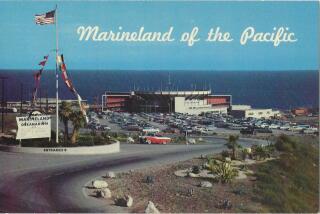Dolphins âAskâ to Be Fed by People at West Australia Beach
MONKEY MIA CARAVAN PARK, Western Australia â It had been 17 years earlier, on a warm September day in 1971, when a wild bottle-nosed dolphin came out of the sea and took a fish from my hand.
The scenery was dramatic: deep-blue sky, ocher-red sandhills clumped with yellowish-greenspinifex and white beaches flanked by translucent turquoise water.
âPlease donât harm tame porpoise,â one sign said near a group fishing off a dilapidated jetty. âAll mammals including dolphins and seals are protected and must not be disturbed or injured in any manner except by persons who are licensed to do so,â read another.
I had heard about Charley, the wild dolphin of Monkey Mia that befriended people. A Malay fisherman told me that several years before he had been the first to feed the dolphin.
âCharlieâs got a chunk missing from his dorsal fin. He was here yesterday playing with a black Lab.â
Eagerly, I stood in knee-deep water and scanned the smooth green sea. Suddenly a tattered dorsal fin cut the surface. I automatically reached forward.
The One Bold One
A sympathetic fisherman, laughing at the large frozen mullet I extended, offered instead several fresh tailor to tempt the dolphin. Other dolphins circled near and one came close. But only Charlie swam up and took a fish between his neat white row of teeth.
I tried to make my borrowed bait last because if there is too long a wait between offerings, Charlie will flounce off and roll over to expose his glistening pale underbelly.
Spurning my frozen mullet and with no more fresh tailor offered, he swam out to deeper water beside the jetty and tried to steal yellow bellies from the rod fishermenâs lines.
The other dolphins edged closer and continued to cut the water near the jetty, but none was brave enough to swim in and take the fish.
Name a Mystery
Now I was back in Monkey Mia, this time on a Cookâs Tour from Geraldton, 270 miles to the south. This time all but 15 1/2 miles of road were sealed. No one knows for sure how Monkey Mia got its name. Some say that the beach is named after a schooner that visited Shark Bay in 1834.
Others say that Monkey Mia is the home or mia (an aboriginal word) of the monkey, which can refer to the ship or to Chinese pearlers.
Monkey Mia is now a thriving metropolis. Thousands of vacationers crowded the car and caravan park, crammed the store, covered the beach and filled the newly constructed jetty. Dozens of others manned boats offshore. Signs proliferated.
The Marine Harbours Department, the Department of Fisheries and Wildlife and the Dolphin Welfare Foundation invited visitors to meet âThe Friendly Dolphins of Monkey Mia.â
But there are rules: Honor the non-boating area. Keep to a five-knot speed limit. Donât pat a dolphinâs head or blowhole. Donât grab its tail or dorsal fin. Donât make noises in the water to frighten them. Donât let your dogs swim with them. Feed them only fresh whole fish that you would eat yourself.
Be gentle with the dolphins and they will be gentle with you.
Charlie Was Gone
But where were they? Charlie had been shot years ago by an irate fisherman. Since then nearly 30 dolphins had come into this remote, unpolluted beach to feed, although only a dozen or so made contact.
They arrive mainly between March and November when winds are lower, tides are higher, temperatures are cooler and their prey feeds in shallower water.
While my tour companions headed for the information center (and so missed the dolphins altogether), I grabbed my cameras and rushed past the cars, the caravans, the boats, the sun-bakers and the fishermen to a long line of people standing by the waterâs edge.
Almost hidden behind them and a flotilla of white pelicans hovering nearby were a few dark shapes, impossible to reach through the crowds.
Excitedly I ran along the jetty for a better view and just managed to click off two quick shots before the dolphins disappeared.
The crowds dispersed. Disappointed, I went back to the information center to talk to the wardens.
âTheyâve been here every day but two in the last seven months,â a man told me. âBut these dolphins are wild. They are not predictable.â
The Common Visitors
Although I had seen only glimpses of them, Bassolo showed me illustrations of the commonest visitors: Holey Fin, who had been coming for 14 years, along with Crooked Fin, Beautiful, Goldie, Nick, Harlequin, Puck and Joy. Each had been clearly identified.
Warden Sharon Gosper said that some of the dolphins switched roles and brought fish to people.
âOne would store several fish in its mouth then spit them out one at a time till they were all mangled. The dolphin would get upset if people didnât catch the fish and throw them back.â
Although some dolphins have been shot or slashed by propellers, Gosper emphasized that most fishermen here really love the dolphins. âThey think it bad luck to have dolphins die on them, so they rock them out of their nets if they get caught, and look after them.â
The dolphins of Monkey Mia are legends. Stories abound about Charlie, who started it. One says he befriended a young girl, who removed a hook from his flesh and then let her ride on his back. Another has Charlie first taking food from residents Nin and Ernie Watts.
With the expansion of a caravan park and improved road access, visitors attracted by the dolphins have increased dramatically, though that may also scare the mammals away.
A Dolphin Welfare Foundation has been established and wardens have been hired to protect the mammals so they can continue to make contact in safety.
-- -- --
Monkey Mia is about 520 miles north of Perth, capital city of Western Australia, 270 miles north of Geraldton, the nearest main town, and 15 miles northeast of Denham, the nearest town with accommodations, bus connections and an airstrip served by Midstate Airlines. Monkey Mia has camping facilities.
To get to Monkey Mia you can use private or public transport or take an inexpensive organized tour. The following companies include Monkey Mia in their itineraries:
Great Western Tours, Westrail Terminal, West Parade, East Perth 6000, Western Australia. Runs seasonal three-day coach tours from Perth (about $195 U.S.) and year-round two-, three- and four-day coach and plane tours from Perth ($373 to $460).
Westrail Travel, City Rail Station, Wellington Street, Perth, Western Australia 6000. Runs year-round, four-day coach tours from Perth ($373).
Pinnacle Coach Tours, Pinnacle Travel Center, Corner Hay and Irwin streets, Perth, Western Australia 6000. Runs year-round and seasonal 3-, 6-, 7-, 10- and 12-day coach tours from Perth ($199 to $1,224).
WA Coach Service, Western Australian Tourist Center, 772 Hay St., Perth, Western Australia 6000. Runs seasonal three-day coach tours from Perth ($198).
Kalbarri Coachlines, Geraldon Tourist Bureau, Chapman Road, Geraldton, Western Australia. Runs two-day coach tours from Geraldton ($122).
For Car Travelers
Monkey mai and denham have numerous caravan parks. Chalets, cottages, hotels and motels abound in Denham (maximum $150 a day).
Recommended are the Shark Bay Hotel-Motel in Denham and and Nanga Sheep Station 32 miles south of Denham, which has a caravan park and cottages ($8 to $30 a day) and the Nanga Barn restaurant, possibly the only sheep station in Australia with a liquor license.
Also recommended is the Billabong Hotel on the North West Coastal Highway at the turnoff to Denham ($35 a night).
Thereâs no guarantee that youâll see dolphins at Monkey Mia, but the most likely times and the best weather conditions are between April and September. The area offers excellent fishing for snapper, jewfish, grouper, mackerel, red emperor, mullet and whiting.
For more details, contact the Tourist Information Center, Shark Bay Tourist Office, Shire of Shark Bay, Denham, Western Australia 6537.
For more information, contact Monkey Mia Dolphin Information Center, Post Office, Denham, or the Western Australia Tourism Commission, 16 St. Georgeâs Terrace, 11th Floor, Perth, Western Australia 6000.
You can also contact the Australian Tourist Commission, 2121 Avenue of the Stars, Suite 1200, Los Angeles 90067, (213) 552-1988.
More to Read
Sign up for Essential California
The most important California stories and recommendations in your inbox every morning.
You may occasionally receive promotional content from the Los Angeles Times.









